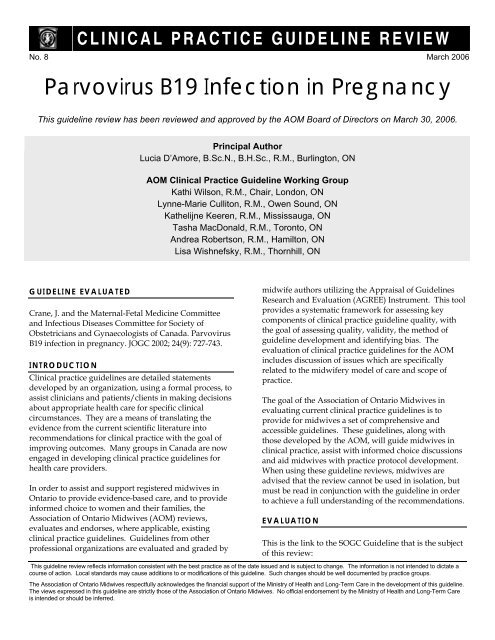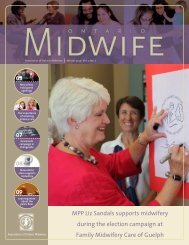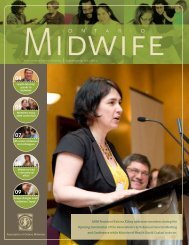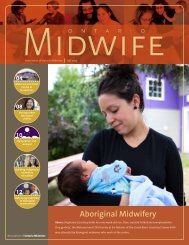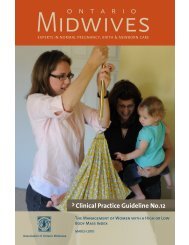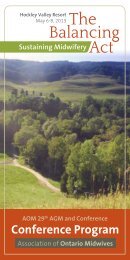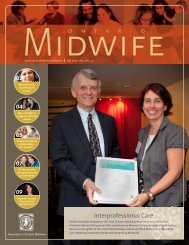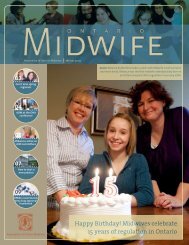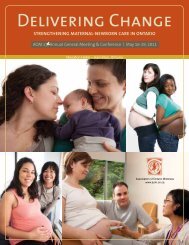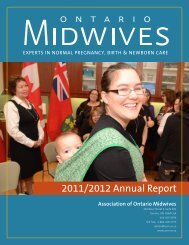Parvovirus B19 Infection in Pregnancy - Association of Ontario ...
Parvovirus B19 Infection in Pregnancy - Association of Ontario ...
Parvovirus B19 Infection in Pregnancy - Association of Ontario ...
You also want an ePaper? Increase the reach of your titles
YUMPU automatically turns print PDFs into web optimized ePapers that Google loves.
CLINICAL PRACTICE GUIDELINE REVIEWNo. 8 March 2006<strong>Parvovirus</strong> <strong>B19</strong> <strong>Infection</strong> <strong>in</strong> <strong>Pregnancy</strong>This guidel<strong>in</strong>e review has been reviewed and approved by the AOM Board <strong>of</strong> Directors on March 30, 2006.Pr<strong>in</strong>cipal AuthorLucia D’Amore, B.Sc.N., B.H.Sc., R.M., Burl<strong>in</strong>gton, ONAOM Cl<strong>in</strong>ical Practice Guidel<strong>in</strong>e Work<strong>in</strong>g GroupKathi Wilson, R.M., Chair, London, ONLynne-Marie Culliton, R.M., Owen Sound, ONKathelijne Keeren, R.M., Mississauga, ONTasha MacDonald, R.M., Toronto, ONAndrea Robertson, R.M., Hamilton, ONLisa Wishnefsky, R.M., Thornhill, ONGUIDELINE EVALUATEDCrane, J. and the Maternal-Fetal Medic<strong>in</strong>e Committeeand Infectious Diseases Committee for Society <strong>of</strong>Obstetricians and Gynaecologists <strong>of</strong> Canada. <strong>Parvovirus</strong><strong>B19</strong> <strong>in</strong>fection <strong>in</strong> pregnancy. JOGC 2002; 24(9): 727-743.INTRODUCTIONCl<strong>in</strong>ical practice guidel<strong>in</strong>es are detailed statementsdeveloped by an organization, us<strong>in</strong>g a formal process, toassist cl<strong>in</strong>icians and patients/clients <strong>in</strong> mak<strong>in</strong>g decisionsabout appropriate health care for specific cl<strong>in</strong>icalcircumstances. They are a means <strong>of</strong> translat<strong>in</strong>g theevidence from the current scientific literature <strong>in</strong>torecommendations for cl<strong>in</strong>ical practice with the goal <strong>of</strong>improv<strong>in</strong>g outcomes. Many groups <strong>in</strong> Canada are nowengaged <strong>in</strong> develop<strong>in</strong>g cl<strong>in</strong>ical practice guidel<strong>in</strong>es forhealth care providers.In order to assist and support registered midwives <strong>in</strong><strong>Ontario</strong> to provide evidence-based care, and to provide<strong>in</strong>formed choice to women and their families, the<strong>Association</strong> <strong>of</strong> <strong>Ontario</strong> Midwives (AOM) reviews,evaluates and endorses, where applicable, exist<strong>in</strong>gcl<strong>in</strong>ical practice guidel<strong>in</strong>es. Guidel<strong>in</strong>es from otherpr<strong>of</strong>essional organizations are evaluated and graded bymidwife authors utiliz<strong>in</strong>g the Appraisal <strong>of</strong> Guidel<strong>in</strong>esResearch and Evaluation (AGREE) Instrument. This toolprovides a systematic framework for assess<strong>in</strong>g keycomponents <strong>of</strong> cl<strong>in</strong>ical practice guidel<strong>in</strong>e quality, withthe goal <strong>of</strong> assess<strong>in</strong>g quality, validity, the method <strong>of</strong>guidel<strong>in</strong>e development and identify<strong>in</strong>g bias. Theevaluation <strong>of</strong> cl<strong>in</strong>ical practice guidel<strong>in</strong>es for the AOM<strong>in</strong>cludes discussion <strong>of</strong> issues which are specificallyrelated to the midwifery model <strong>of</strong> care and scope <strong>of</strong>practice.The goal <strong>of</strong> the <strong>Association</strong> <strong>of</strong> <strong>Ontario</strong> Midwives <strong>in</strong>evaluat<strong>in</strong>g current cl<strong>in</strong>ical practice guidel<strong>in</strong>es is toprovide for midwives a set <strong>of</strong> comprehensive andaccessible guidel<strong>in</strong>es. These guidel<strong>in</strong>es, along withthose developed by the AOM, will guide midwives <strong>in</strong>cl<strong>in</strong>ical practice, assist with <strong>in</strong>formed choice discussionsand aid midwives with practice protocol development.When us<strong>in</strong>g these guidel<strong>in</strong>e reviews, midwives areadvised that the review cannot be used <strong>in</strong> isolation, butmust be read <strong>in</strong> conjunction with the guidel<strong>in</strong>e <strong>in</strong> orderto achieve a full understand<strong>in</strong>g <strong>of</strong> the recommendations.EVALUATIONThis is the l<strong>in</strong>k to the SOGC Guidel<strong>in</strong>e that is the subject<strong>of</strong> this review:This guidel<strong>in</strong>e review reflects <strong>in</strong>formation consistent with the best practice as <strong>of</strong> the date issued and is subject to change. The <strong>in</strong>formation is not <strong>in</strong>tended to dictate acourse <strong>of</strong> action. Local standards may cause additions to or modifications <strong>of</strong> this guidel<strong>in</strong>e. Such changes should be well documented by practice groups.The <strong>Association</strong> <strong>of</strong> <strong>Ontario</strong> Midwives respectfully acknowledges the f<strong>in</strong>ancial support <strong>of</strong> the M<strong>in</strong>istry <strong>of</strong> Health and Long-Term Care <strong>in</strong> the development <strong>of</strong> this guidel<strong>in</strong>e.The views expressed <strong>in</strong> this guidel<strong>in</strong>e are strictly those <strong>of</strong> the <strong>Association</strong> <strong>of</strong> <strong>Ontario</strong> Midwives. No <strong>of</strong>ficial endorsement by the M<strong>in</strong>istry <strong>of</strong> Health and Long-Term Careis <strong>in</strong>tended or should be <strong>in</strong>ferred.
http://sogc.medical.org/guidel<strong>in</strong>es/pdf/ps119.pdfThe purpose <strong>of</strong> this cl<strong>in</strong>ical practice guidel<strong>in</strong>e is toreview the effects <strong>of</strong> parvovirus <strong>B19</strong> on the pregnantwoman and fetus, and to outl<strong>in</strong>e the options formanagement <strong>of</strong> women who are exposed to or contractthis disease <strong>in</strong> pregnancy.The guidel<strong>in</strong>e was evaluated by the pr<strong>in</strong>cipal authorus<strong>in</strong>g the AGREE <strong>in</strong>strument, and found to be <strong>of</strong> highoverall quality. The strengths were related to cl<strong>in</strong>icaldata, quality, and applicability <strong>of</strong> recommendations. Aparticular strength <strong>of</strong> this cl<strong>in</strong>ical practice guidel<strong>in</strong>e as itrelates to midwifery is the clear del<strong>in</strong>eation <strong>of</strong> prenatalmanagement and tim<strong>in</strong>g <strong>of</strong> referral to a tertiary carecentre. The ma<strong>in</strong> areas <strong>of</strong> weakness related to structuralomissions, <strong>in</strong>clud<strong>in</strong>g statements regard<strong>in</strong>g potentialconflicts <strong>of</strong> <strong>in</strong>terest, and lack <strong>of</strong> patient <strong>in</strong>volvement <strong>in</strong>guidel<strong>in</strong>e development.OVERALL EVALUATION OF CLINICALPRACTICE GUIDELINE: RECOMMENDEDThe recommendations conta<strong>in</strong>ed <strong>in</strong> the SOGC Cl<strong>in</strong>icalPractice Guidel<strong>in</strong>e “<strong>Parvovirus</strong> <strong>B19</strong> <strong>Infection</strong> <strong>in</strong><strong>Pregnancy</strong>” should be applied to midwifery practice.SUMMARY OF RECOMMENDATIONS1. Pregnant women exposed to, or who developsymptoms <strong>of</strong> parvovirus <strong>B19</strong> <strong>in</strong>fection should beassessed to determ<strong>in</strong>e if they are susceptible to<strong>in</strong>fection (nonimmune) or if they have a current<strong>in</strong>fection, by determ<strong>in</strong><strong>in</strong>g their parvovirus <strong>B19</strong> IgGand IgM status. (II-2A)2. If parvovirus <strong>B19</strong> IgG is present and IgM is negative,the woman is immune and can be reassured that shewill not develop <strong>in</strong>fection and that the virus will notadversely affect her pregnancy. (II-2A)3. If both parvovirus <strong>B19</strong> IgG and IgM are negative(and the <strong>in</strong>cubation period has passed), the womanis not immune and has not developed the <strong>in</strong>fection.Although she may wish to m<strong>in</strong>imize furtherexposure, leave from the workplace is controversialand is not rout<strong>in</strong>ely recommended. Further studiesare needed <strong>in</strong> this area. (III-B)4. If a recent parvovirus <strong>B19</strong> <strong>in</strong>fection has beendiagnosed <strong>in</strong> the woman, then referral to anobstetrician or a maternal-fetal medic<strong>in</strong>e specialistshould be considered (III-B). The woman should becounselled regard<strong>in</strong>g risks <strong>of</strong> fetal transmission, fetalloss, and hydrops. Serial ultrasounds should beperformed up to 8 to 12 weeks after <strong>in</strong>fection todetect the development <strong>of</strong> hydrops. (III-B) Ifhydrops develops, referral to a maternal-fetalmedic<strong>in</strong>e specialist should be made andconsideration should be given to fetal bloodsampl<strong>in</strong>g and <strong>in</strong>travascular transfusion. (II-2B)CURRENT RESEARCHA review <strong>of</strong> the literature was conducted us<strong>in</strong>gMEDLINE. The major focus <strong>of</strong> the literature review wason research published from January 2002 through March2005, as this represents data that was released aftercompletion <strong>of</strong> the evaluated guidel<strong>in</strong>e.There has been some valuable literature publishedregard<strong>in</strong>g the detection and management <strong>of</strong> parvovirus<strong>B19</strong> <strong>in</strong> pregnancy s<strong>in</strong>ce the publication <strong>of</strong> the SOGCcl<strong>in</strong>ical practice guidel<strong>in</strong>e.Although rout<strong>in</strong>e screen<strong>in</strong>g <strong>of</strong> women for parvovirus<strong>B19</strong> susceptibility is not recommended <strong>in</strong> the reviewedguidel<strong>in</strong>e, much attention is paid to the identification <strong>of</strong>at-risk populations. There is value <strong>in</strong> health careproviders hav<strong>in</strong>g an awareness <strong>of</strong> the populations morelikely to encounter parvovirus <strong>B19</strong> <strong>in</strong> pregnancy.Accord<strong>in</strong>gly, there has been some debate as to thepotential value <strong>of</strong> rout<strong>in</strong>e screen<strong>in</strong>g <strong>of</strong> “high-risk”women for parvovirus <strong>B19</strong> titers. A statistical analysisdone by Fean et al. 1 , clearly <strong>in</strong>dicates that this practiceshould not be recommended. With 1-3% <strong>of</strong> pregnanciesbe<strong>in</strong>g complicated by parvovirus <strong>B19</strong> <strong>in</strong>fection, and anoverall fetal mortality rate <strong>of</strong> 0.6%, it is not felt thatrout<strong>in</strong>e screen<strong>in</strong>g <strong>in</strong> the first trimester would be a costeffective practice 1 . (III-B) As Fean states, “To prevent 1.5fetal losses, 50,000 women would need to be screenedregularly from the first trimester” 3 .Identify<strong>in</strong>g women who have been exposed to, or showsymptoms <strong>of</strong>, parvovirus <strong>B19</strong> <strong>in</strong>fection has thus far beenthe only strategy for identify<strong>in</strong>g fetuses at risk. A recentprospective study published by Simchen et al. 2 illustratesthe value <strong>in</strong> <strong>in</strong>terpret<strong>in</strong>g ultrasounds as they may relateto parvovirus <strong>B19</strong> <strong>in</strong>fection. The ultrasound detection <strong>of</strong>a hyperechogenic focus <strong>in</strong> the fetal liver is a relativelycommon f<strong>in</strong>d<strong>in</strong>g, with an <strong>in</strong>cidence <strong>of</strong> 1:1000 2 . Althoughthis ultrasound f<strong>in</strong>d<strong>in</strong>g is <strong>of</strong>ten associated with thepresence <strong>of</strong> other congenital abnormalities, its presence<strong>in</strong> isolation may <strong>in</strong>dicate fetal <strong>in</strong>fection 2 . There weretwo cases <strong>of</strong> fetal <strong>in</strong>fection identified <strong>in</strong> this study <strong>in</strong>relation to a hyperechogenic focus <strong>in</strong> the liver; one wasparvovirus <strong>B19</strong> and the other was cytomegalovirus 2 .The f<strong>in</strong>d<strong>in</strong>gs <strong>of</strong> this study suggest that one may consider<strong>in</strong>vestigat<strong>in</strong>g potential parvovirus <strong>B19</strong> <strong>in</strong>fection <strong>in</strong> theAOM 2 March 2006
presence <strong>of</strong> a hyperechogenic focus <strong>in</strong> the fetal liver onultrasound. (II-2B)There has been new research published <strong>in</strong> regard to theseverity <strong>of</strong> parvovirus <strong>B19</strong> <strong>in</strong>fection after 20 weeksgestation, s<strong>in</strong>ce the release <strong>of</strong> the SOGC guidel<strong>in</strong>e. TheSOGC cl<strong>in</strong>ical practice guidel<strong>in</strong>e states the fetal loss rateafter 20 weeks gestation to be 2.3%, as it relates tospontaneous demise and a hydropic presentation 3 .There is compell<strong>in</strong>g evidence to suggest that parvovirus<strong>B19</strong> is a more significant contributor to fetal morbidityand mortality after 20 weeks gestation than previouslybelieved. A study by Genen et al. 4 performedpathological test<strong>in</strong>g on the placentas <strong>of</strong> neonates withunexpla<strong>in</strong>ed systemic illness and poor neonataloutcomes. It was found that there was a high <strong>in</strong>cidence<strong>of</strong> previously undetected <strong>in</strong>fection <strong>in</strong> placentalspecimens, with 4 % <strong>of</strong> specimens test<strong>in</strong>g positive forparvovirus <strong>B19</strong> 4 .Also support<strong>in</strong>g these f<strong>in</strong>d<strong>in</strong>gs is a retrospectiveanalysis by Norbeck et al. 5 . This study exam<strong>in</strong>ed bothplacental and fetal tissue <strong>in</strong> cases <strong>of</strong> <strong>in</strong>trauter<strong>in</strong>e fetaldeath (IUFD) <strong>in</strong> late gestation. <strong>Parvovirus</strong> <strong>B19</strong> <strong>in</strong> thisstudy was present <strong>in</strong> 14% <strong>of</strong> IUFD cases 5 . This suggeststhat the <strong>in</strong>cidence <strong>of</strong> parvovirus <strong>B19</strong> related <strong>in</strong>trauter<strong>in</strong>efetal death <strong>in</strong> the later half <strong>of</strong> pregnancy may be muchgreater than the 2.3% loss rate quoted <strong>in</strong> the SOGCcl<strong>in</strong>ical practice guidel<strong>in</strong>e. It is suggested that althoughthe risk <strong>of</strong> fetal hydrops decreases significantly after 20weeks gestation, the risk <strong>of</strong> fetal death does not 5 . Theabove studies suggest that rout<strong>in</strong>e parvovirus <strong>B19</strong><strong>in</strong>vestigation <strong>in</strong> all cases <strong>of</strong> IUFD and unexpla<strong>in</strong>edsystemic illness and poor neonatal outcome may bewarranted. (II-2A)ADDITIONAL MIDWIFERY CONSIDERATIONSMidwives are <strong>in</strong> an ideal position as primary health careproviders to ensure vigilance regard<strong>in</strong>g the detectionand management <strong>of</strong> parvovirus <strong>B19</strong> <strong>in</strong>fection <strong>in</strong>pregnancy. The model <strong>of</strong> midwifery care permitsmidwives to counsel women regard<strong>in</strong>g the existence <strong>of</strong>parvovirus <strong>B19</strong>, to identify at risk populations, andensure the timely report<strong>in</strong>g <strong>of</strong> <strong>in</strong>fectious diseaseexposure.<strong>in</strong> cases <strong>of</strong> <strong>in</strong>trauter<strong>in</strong>e fetal death or unexpla<strong>in</strong>edneonatal morbidity and mortality, if it is not already<strong>in</strong>cluded <strong>in</strong> rout<strong>in</strong>e <strong>in</strong>vestigations for these situations.Overall, the “<strong>Parvovirus</strong> <strong>B19</strong> <strong>Infection</strong> <strong>in</strong> <strong>Pregnancy</strong>”cl<strong>in</strong>ical practice guidel<strong>in</strong>e is a very useful tool formidwives. It provides clear guidel<strong>in</strong>es for tim<strong>in</strong>g and<strong>in</strong>terpretation <strong>of</strong> serology test<strong>in</strong>g, as well as outl<strong>in</strong><strong>in</strong>g<strong>in</strong>dications for referral to an obstetrician and/ormaternal-fetal medic<strong>in</strong>e specialist.CONCLUSIONAfter evaluation us<strong>in</strong>g the AGREE <strong>in</strong>strument andassessment <strong>of</strong> the current literature, the <strong>Association</strong> <strong>of</strong><strong>Ontario</strong> Midwives recommends the application <strong>of</strong> theSOGC Cl<strong>in</strong>ical Practice Guidel<strong>in</strong>e, “<strong>Parvovirus</strong> <strong>B19</strong><strong>Infection</strong> <strong>in</strong> <strong>Pregnancy</strong>” to midwifery practice, withthese additional recommendations:• Midwives should be aware <strong>of</strong> at risk populationswho may encounter parvovirus, but rout<strong>in</strong>escreen<strong>in</strong>g with<strong>in</strong> these populations is not warranted.• The ultrasound detection <strong>of</strong> hyperechogenic focus <strong>in</strong>the fetal liver should prompt test<strong>in</strong>g for <strong>Parvovirus</strong><strong>B19</strong>. (II-2B)• <strong>Parvovirus</strong> <strong>B19</strong> <strong>in</strong>fection is associated with adverseoutcomes after 20 weeks gestation, and does <strong>in</strong>dicatereferral to a maternal-fetal medic<strong>in</strong>e specialist.REFERENCES1. Fean WS, Yee CF, C<strong>in</strong>cotta RB, Tilse M. Human parvovirus <strong>B19</strong><strong>in</strong>fection <strong>in</strong> pregnancy: should screen<strong>in</strong>g be <strong>of</strong>fered to the lowriskpopulation? Aust N Z J Obstet Gynaecol 2002;42(4): 347-351.2. Simchen MJ, Toi A, Bona M, Alkazaleh F, Ryan G, Chitayat D.Fetal hepatic calcifications: prenatal diagnosis and outcome. Am JObstet Gynecol 2002;187(6):1617-22.3. Crane J. and the Maternal-Fetal Medic<strong>in</strong>e Committee and theInfectious Diseases Committee for the Society <strong>of</strong> Obstetriciansand Gynaecologists <strong>of</strong> Canada. <strong>Parvovirus</strong> <strong>B19</strong> <strong>in</strong>fection <strong>in</strong>pregnancy. JOGC 2002;24(9):727-743.4. Genen L, Nuovo GJ, Krilov L, Davis JM. Correlation <strong>of</strong> <strong>in</strong> situdetection <strong>of</strong> <strong>in</strong>fectious agents <strong>in</strong> the placenta with neonataloutcome. J Pediatr 2004;144(3):316-320.5. Norbeck O, Papadogiannakis N, Petersson K, Hirbod T, Broliden K,Tolfvenstam T. Revised cl<strong>in</strong>ical presentation <strong>of</strong> parvovirus <strong>B19</strong>-associated <strong>in</strong>trauter<strong>in</strong>e fetal death. Cl<strong>in</strong> Infect Dis2002;35(9):1032-1038.The significant body <strong>of</strong> literature published s<strong>in</strong>ce thecl<strong>in</strong>ical practice guidel<strong>in</strong>e reviewed does suggestadditional recommendations should be made.Midwives should consider parvovirus <strong>B19</strong> screen<strong>in</strong>g <strong>in</strong>cases <strong>of</strong> hyperechogenic foci <strong>in</strong> the fetal liver identifiedby ultrasound. When work<strong>in</strong>g with the obstetric team,midwives should advocate for parvovirus <strong>B19</strong> screen<strong>in</strong>gAOM 3 March 2006


